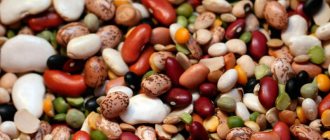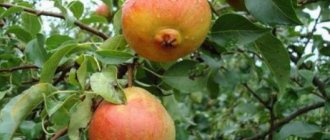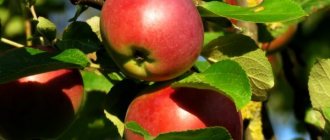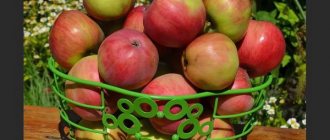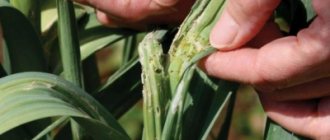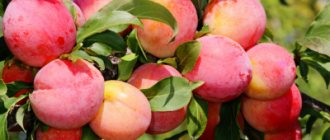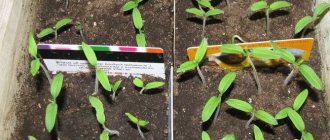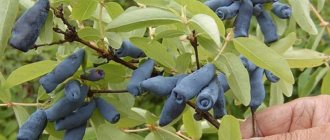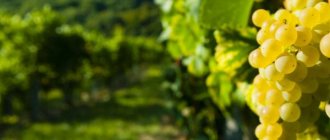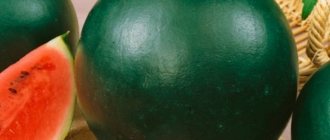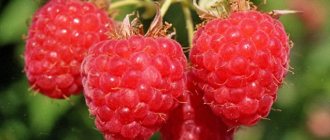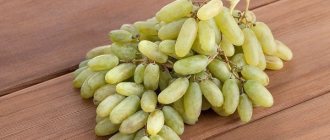Yellow (White) Honey plum is a favorite of gardeners. Its fruits are distinguished by their pronounced sweetness and beautiful appearance. Its advantages also include early harvest and relative ease of care. Therefore, the Honey plum is popular not only among professionals, but also among beginning farmers.
History of the variety's creation
The homeland of the Honey plum variety is Ukraine. This fruit tree was bred in Donetsk at the branch of the Institute of Horticulture of the Ukrainian Academy of Agrarian Sciences. The work was carried out by a group of breeders under the leadership of senior researcher Liliya Ivanovna Taranenko. The result was a variety that is unpretentious and can take root both in the south and in the north of the country.
According to the description, in the State Register of the Russian Federation, Honey plum is recommended for cultivation throughout the Central region.
History of variety selection
The homeland of the white plum is Ukraine. The authorship belongs to the talented scientist L. I. Taranenko. Due to the amber color of the fruit, the early yellow honey plum is also called, and there is also a name such as White Ukrainian. When registering, the breeder designated the crop exactly as Honey White. Other names are considered folk. The plum has spread throughout all the republics of the former Soviet Union and has taken root in the private plots of gardeners.
The video talks about the White Honey variety:
Main characteristics
Honey plum is a tall tree, which in warm regions can reach 6-7 m. In the Central zone and northern Russia, the tree usually grows no more than 3-5 m. It develops a few skeletal branches that form a beautiful spherical crown. At the same time, it turns out to be unthickened, which is good for fruit ripening.
The plum tree begins to bloom in early to mid-May with beautiful white flowers. The fruits ripen early - in early to mid-July. Their amber-yellow color is fully reflected in the name of the Honey Yellow plum variety. The variety is also known as White Honey Plum, but these names are synonymous. The fruits are called white because of the whitish waxy coating that is easily wiped off.
The variety is a frost-resistant variety of plum and can be grown in different regions, even in the north. At the same time, gardeners note that the quality of the fruit does not depend on whether the tree grows in a warm or cold climate.
Honey plum has good immunity and is resistant to most common fungal diseases that affect fruit trees. However, it is susceptible to pest attacks and will require the use of insecticides to obtain a bountiful harvest.
Characteristics of the variety
All descriptions of Belaya plum emphasize the variety’s unpretentiousness and resistance to bad weather conditions.
Winter hardiness of honey plum
The yellow plum variety has good winter hardiness. To this quality you can also add drought resistance. Regardless of climatic conditions, the yield and taste of fruits do not change.
Advice! Despite its high drought resistance, the variety loves abundant watering, like all other plums.
Pollinators of the White honey plum
The Yellow Honey plum begins to bloom in early spring. In the south, the fruit ripens in July. Residents of the northern regions harvest in August. The variety is considered self-sterile. Pollinators are needed to produce crops. The best varieties are considered to be Hungarian and Renklod Kuibyshevsky. Ukrainian gardeners often call the white plum Honey Artemovskaya. To pollinate the crop, any related plum trees are planted nearby.
Attention! Frosts and drought do not affect the quality of pollination.
Productivity and fruiting
On average, the Honey plum begins to bear fruit in the fourth year from the moment of planting. It all depends on compliance with the rules of agricultural technology and climatic conditions. Up to 35 kg of harvest is collected from the tree. The weak point of the white plum is considered to be wood. When the harvest is abundant, the branches break. The trunk may even split. Supports made from sticks help save the crown.
Attention! If planted incorrectly, the Honey yellow plum may not bear fruit for 4 years. If the seedling is initially deeply buried, the bark ripples. The plum will grow slowly and produce poor harvests.
Area of application of berries
White and yellow fruits are considered universal. The fruit can be frozen, eaten fresh, and used for all types of processing. Because of the beauty of the yellow pulp and dessert taste, plums are used to decorate banquet tables for celebrations.
Resistance to diseases and pests
Numerous reviews of the White Honey plum say that the variety is not afraid of moniliosis. The greatest danger to the crop is hole spotting, rust, as well as fungi that cause fruit rot. Preventive spraying with fungicides helps prevent the spread of diseases.
Advantages and disadvantages of the variety
The Honey Yellow plum variety was developed during a difficult period when the country's residents were in dire need of vitamin-rich food products. These were the post-war years. Breeders tried to make the variety productive under any growing conditions.
The advantages include the following:
- The variety is not afraid of temperature changes. The yield indicator is maintained if the plum suffers return frosts or drought.
- The yellow plum variety adapts to almost all weather conditions of the republics of the post-Soviet space.
- Early ripening of fruits, delicate dessert taste of the pulp. The yellow, universal fruit is suitable for making desserts, preserving, and can withstand long-term transportation.
- A big advantage is that when pollinated by other plum varieties, White Honey plums do not change the quality of the fruit.
The only drawback is the large crown size. To limit growth, gardeners resort to frequent pruning. Folk breeders are trying to cross White Honey with dwarf varieties to get a small tree, but without compromising the quality of the fruit.
Description of fruits
Honey Yellow Plum is famous for its fruits. They turn out large, round in shape. The average weight of one fruit is 40-50 g. The fruits are sweet with a slight, barely noticeable sourness. The pulp is soft and juicy, with a delicate aroma and honey flavor. According to the description of professional tasters, the taste qualities of the Medovaya plum variety are rated 4.5 points out of 5.
The fruits are covered with a dense skin, which is practically not felt while eating. However, it prevents the plums from cracking. They can be transported over long distances without losing their appearance. Therefore, the variety is often used in commercial gardens.
Harvest: a sea of yellow fruits
Honey white begins to bear fruit 3–4 years after planting. The tree reaches its maximum yield (40–50 kg) at the age of 10–12 years. The variety is an early ripening variety; the harvest ripens, depending on the region, in late July - early August. Harvesting plums begins from the lower branches, carefully placing the fruits in prepared containers. The shelf life reaches 2 months.
White honey is used fresh and for canned preparations
The use of Medovaya fruits is very diverse: they are consumed fresh, processed into jams and marmalade, and prepared into drinks. Large and aromatic berries are good in any form.
Pollinator trees
The honey variety is self-sterile, so pollinators must be planted for it. As companions, you should choose plums that have the same flowering period. The best neighbors in the garden for Medova will be Renklod early, Renklod Karbysheva or Hungarian Donetsk early. By the way, they are also the result of the selection work of Liliya Ivanovna.
Renklod early
Renklod Karbysheva
Hungarian Donetsk early
When planting several trees, a distance of at least 3 m must be maintained between seedlings.
If it is not possible to plant several trees on the site, then a branch of a different variety can be grafted onto the Honey plum. The tree will turn out to be very unusual, but you will need to be patient while waiting for the fruit.
Reviews about the Honey plum variety
The White Honey Plum has practically no drawbacks, but gardeners note some problems when growing it.
- Maxim Oleynik : “Good plum. He responds well to quality care. If you trim it and feed it in time, the harvest will be large. Every year we remove 25-30 kg from our trees. They are enough for canning and just for eating, they are very good, sweet. The color of the peel is beautiful, yellow, but because of the coating they look white.”
- Elena Zhuk : “When we decided to plant a plum tree, the choice fell on Medovaya. She seemed the sweetest to us. For the first 3 years I didn’t get sick with anything, then spots appeared on the leaves. I don’t know what it was, but after spraying it with fungicides 3 times, they disappeared. The yield of plums is high, at least for personal needs, so we recommend it.”
- Dmitry Zhurba : “Several years ago I grew this plum, but then I had to replace it with other varieties. It is certainly sweet and transportable, but the yield is low. There was little for sale, and it was for this that plums were grown. In addition, the caterpillars love the variety, so you have to spray it often.”
Productivity
The yield of one tree is 30-35 kg. If in the spring the flowering is not affected by negative weather factors (strong winds, heavy rains), then the tree can bear even more fruit. Fruiting usually begins 4-5 years after the seedling is planted in the ground. Happens annually.
If an adult tree has many flowers, it is recommended to place supports under the branches. This is done so that the abundance of fruits does not break the branches under its weight.
If there are too many flowers or ovaries on a young tree, it is recommended to tear off some of them so that the plum has enough strength to feed the existing fruits.
Plum harvesting, storage and transportation
Harvesting is the most pleasant reward for a gardener’s work.
The fruits of the Honey White Plum variety ripen early, and the fruits are sometimes very easily separated from the branch. As soon as you touch the tree, the rainfall begins. That is why gardeners came up with the idea of laying some material (film) near the tree in order to remove fallen fruits along with it.
Plums should be harvested before they are technically ripe, as they can easily ripen in a box or other container. Slightly unripe fruits are used in compotes. Overripe - in jam, marmalade, marmalade.
One tree can produce up to 35 kg of berries
. Collection should be carried out, if possible, in dry, cool, windless weather.
In the first two weeks, plums can be stored at a temperature of about 0°C, then at a temperature of 5–6°C and a humidity of 85–90%. In the room where plums are stored, the air must be humid - 85 - 90% relative air humidity, otherwise the plums wither and spoil very quickly. Long-term storage at a temperature of 0 - minus 0.5 ° C leads to browning of the pulp.
https://www.bestgardener.ru/literature/sliva_11.shtml
Transportation of berries not treated with chemicals should not take more than 3–4 days. You need to pour the fruits into boxes of no more than 5–6 kg, otherwise you risk losing part of the batch. A prerequisite is to ensure access of dry air to the fruits.
After harvesting, plums should be processed as soon as possible and should not be stored for a long time.
Diseases and pests
The Honey plum variety is highly resistant to peptic ulcers. However, it can also be affected by various diseases. Among the most common are:
- perforated spotting;
- gum therapy;
- rust;
- fruit rot;
- coccomycosis;
- sooty fungus.
The tree is also subject to massive attacks by parasites that spoil the bark, foliage and the fruits themselves. In advanced cases, pests can completely destroy the crop. Most often, plums are affected by plum sawfly, codling moth, scale insects, aphids and weevils.
If there are signs of disease development or pests, the fruit tree is treated with fungicides and insecticides. For minor infections, folk methods can help, but they are less effective compared to industrial means.
It is best to follow prevention methods that reduce the likelihood of plant damage:
- timely pruning;
- moderate watering;
- loosening the soil and eliminating weeds;
- removal and destruction of damaged areas (foliage, branches and fruits);
- whitewashing of the trunk and skeletal branches.
Features of agricultural technology
Honey yellow is simple in agricultural technology, which is also its great advantage.
Landing
For planting, it is better to choose annual seedlings with good roots.
The best time for planting seedlings in the middle zone is spring . The place should be sunny, windproof, located far from groundwater.
- Pit preparation begins in 2–3 weeks before the main work. Ideally, you should take care of the hole in the fall. Dug hole deep 80 cm and with approximately the same diameter it is “fertilized” with a mixture of soil and humus (compost or peat).
Scheme of a planting pit for a plum tree.
- Having poured out half the soil and formed a hill, a tree is planted in it with straightened root system, the rest of the soil is filled in, lightly compacted and spilled with water, approximately 1 bucket.
If after watering the ground subsides significantly, you need to add soil. It is better to immediately cover the tree trunk circle with organic mulch.
Important: planting is rarely done in the fall, since young seedlings do not yet have sufficient frost resistance to survive the cold winter.
Trimming
For the Honey Yellow Plum, 3 types of pruning are carried out:
- sanitary;
- thinning;
- supporting (increasing fruiting).
The most commonly used type of sparse-tiered pruning. In the first year, at least 40 cm , and then over the course of 5 years 3 tiers are formed , each consisting of 5–7 skeletal branches .
Watering
Like all plum crops, this variety is very responsive to watering , even though it has a good degree of drought resistance.
The tree can be watered 3-4 times a season under normal conditions and even rainfall. Excess moisture associated with increased frequency of watering can inhibit growth.
Top dressing
Humus for early spring feeding.
Potassium sulfate for feeding before flowering.
Potassium humate solution for foliar feeding.
Since humus is introduced into the planting hole, there is no need to fertilize the tree in the first year. Feeding begins when the tree reaches two years of age (provided that an annual plant ).
- In the spring, nitrogen-containing fertilizers are applied , for example organic matter, which stimulates development and growth well. Immediately before flowering begins, the soil in the tree trunk circle is thoroughly loosened and fertilized with potassium sulfate and urea .
- At the time of fruiting , you can stimulate the crop by fertilizing the soil with urea and nitrophoska. At the end, you can feed the tree with superphosphate and potassium sulfate. The Honey Yellow variety is very responsive to potassium-containing fertilizers . During the season, you can spray the tree with potassium humate 2-3 times .
Important: you cannot add nitrogen-containing organic matter in the fall, otherwise the plant will begin to grow just before winter.
Advantages and disadvantages
Honey plum is distributed throughout the country and is deservedly very popular. Among its positive characteristics are:
- early ripeness;
- quality and taste of fruits;
- high stable yield;
- frost resistance;
- good immunity.
Plum has relatively few disadvantages, and they are fully compensated by its advantages. Nevertheless, they exist, and the most significant among them are:
- non-self-fertility (need for pollinating companions);
- the height of an adult tree can reach 5 m, so harvesting is not very convenient;
- The fruits are so heavy that they can break branches, so it is necessary to install supports.
Description of the variety (with photo)
The trees are spreading, tall and branched. Every year many new growths are formed, on which flowers and then fruits are set in the first year.
The honey white plum is a tall massive tree with many branches
Under favorable conditions, the height of the tree reaches seven meters . The crown of the plum forms beautifully: semi-round with a small number of main branches. True, a tree, like any garden crop, requires care and timely pruning.
Important! The tree needs pollination from other plums, such varieties as Renklod Karbysheva, Early Hungarian. That is, plum trees that bloom at the same time as the Honey White Plum. The property of not pollinating on its own and not setting fruit without third-party trees is called self-sterility .
The fruits of the Honey White Plum are large, from 30 to 50 grams, with a thick yellow skin with a white coating of medium intensity. The fruits are very reminiscent of cherry plum, but they are completely different crops. Ripe plum berries have a slightly orange blush. The shape of the fruit is semi-round - pear-shaped, mostly oval. Their correct shape allows transportation without a large percentage of loss. The thick skin prevents excessive cracking and broken fruit. The seed inside the berry is small, easily separated, round, flattened.
Plum seeds contain vitamin B12, which has anti-cancer properties. Therefore, tincture of seeds is considered to be a prophylactic against cancer, as well as against bronchitis, cough, lower back pain, gout, rheumatism, atherosclerosis, colds, and sore throat. Plum infusion is used to treat the kidneys, accelerate the outflow of bile and urine, which contributes to a more intensive cleansing process of the body. It is recommended to make a tincture of the seeds using the pulp of the fruit. Thus, the infusion acquires additional beneficial substances: vitamins, minerals, tannins and acids, pectins. The most common method of using tincture among people is to combat diseases of the genitourinary system and treat constipation.
To prepare the tincture you will need 0.5 kg of plum and 1.5 liters. vodka.
The pulp of the Honey White Plum is tender, juicy, sweet, and the pit is easy to separate
Honey plum fruits are widely used in cooking due to their excellent taste. They bake pies, make compotes, marshmallows, jam, sweets, preserves, jams, etc.
It is useful to eat fruits without heat treatment. The versatility of using plums allows gardeners to make early harvests in addition to being a simple fresh delicacy.
The plum blossoms in May, flowering and pollination continue throughout the month, then the fruits set. Already in July you can harvest the Honey White Plum. It is pleasant to note that the plum harvest is stable in any climatic and weather conditions. Even in northern regions or with strong temperature changes, the tree produces a consistent, rich harvest of large-sized fruits with excellent taste.
Description of white honey plum seedling
Landing
The Honey plum variety has many positive reviews from gardeners due to its unpretentiousness and good survival rate. It is successfully grown both in the south and in northern latitudes. However, when planting a young tree, preference should be given to spring. When planting in autumn, there is a possibility of roots and branches freezing. And during the spring-summer period the tree will have time to get stronger.
To plant plums, you need to select a site located in the sun and not shaded by other tall trees and buildings. You should also avoid lowlands where precipitation accumulates - stagnant water can lead to rotting of the root system. For the same reason, it is necessary that the groundwater on the site be located at least 2 m below ground level.
Honey plum prefers fertile loamy or sandy soils with low acidity levels. To deoxidize the soil, you should use lime, dolomite flour or wood ash. The latter can also be used as a natural fertilizer.
When preparing a planting hole, it must be taken into account that it must be prepared in advance. That is, in the fall - if planting is planned for spring, or in early September - if the work will be carried out in late autumn.
The description of the step-by-step process of planting the Honey plum variety is as follows:
- The hole is dug to a depth of 50 cm and a diameter of 60-70 cm. The top fertile layer (20-25 cm) is laid aside separately - it will be needed to prepare the soil.
- A drainage made of broken brick or crushed stone is laid at the bottom, and a support is installed (a thick, tall wooden stick).
- The pit is filled with soil, which is prepared as follows: for 2 buckets of fertile soil, use 1 bucket of organic fertilizer (rotted manure or compost), 400 g of superphosphate or 1 liter of wood ash. On clay soils, add an additional bucket of sand.
- Before planting, the hole is dug halfway and a small mound is formed at the bottom, on which the seedling is placed.
- The roots are straightened in different directions and carefully buried in soil so that the root collar is above ground level.
- Form a tree trunk circle with a roller and a trench, into which I pour 2-2.5 buckets of warm, settled water.
- The tree trunk circle is mulched.
There is no need to prune the White Honey plum immediately after planting. The tree does not respond well to unnecessary pruning. It is necessary to remove only those branches on which damage is found.
Planting and caring for honey yellow plum
To grow white honey plum you do not need to have any special knowledge. However, a seedling simply planted on a plot may not bring the desired harvest. To get a good fruit tree, you need to follow simple rules of agricultural technology.
Recommended timing
It is better to propagate early honey plum by seedlings. The optimal time for planting is considered to be early spring, starting in March. The site has been being prepared since October. Gardeners in the southern regions prefer autumn planting of plums. The site is prepared at least two weeks in advance. The procedure consists of sprinkling lime and humus, followed by digging up the soil.
Choosing a suitable location
Early Honey Plum grows well in a sunny area with clay or sandy soil. The main requirement is the presence of large free space. Neighboring trees should be at a distance of at least 3 m, and it is better to maintain 5 m. The yellow plum variety does not like swampy areas.
What crops can and cannot be planted nearby?
The White Honey variety gets along well with cherry plum and other plums. In addition, they are pollinators. Gardeners in cold regions recommend planting the White Honey plum with the Opal plum due to the similarity of some characteristics. Both crops are frost-resistant, tall, and have a spreading crown. The Opal variety is self-fertile and is a good pollinator for the white Honey plum.
The culture gets along well with cherries, sweet cherries, apple trees, apricots, and peaches. Elderberry growing nearby will protect the plum from aphids.
Bad neighbors include all types of currants, birch, pear, and walnut. Close proximity of coniferous trees is undesirable.
Selection and preparation of planting material
Experienced gardeners categorically recommend buying white plum seedlings only from a nursery. The main requirement for good planting material is a developed root system, an even trunk with intact bark. The presence of living fruit buds is mandatory. It is better to buy seedlings of the Yellow Honey plum variety with a height of up to 1.5 m. Taller trees will not take root well. A seedling with a closed root system is planted together with a lump of earth. If you bought a white plum with bare roots, before planting, soak them for a couple of hours in a bucket of water, adding the drug Kornevin.
Landing algorithm
Numerous reviews from summer residents about the Honey plum say that planting is carried out according to generally accepted rules. You need to do the following:
- They begin to dig a hole by removing fertile soil about 30 cm thick. It is put aside. All other infertile soil is removed from the pit. It won't be useful in the future. The size of the hole depends on the root system of the seedling. Usually 60 cm of depth and width is enough.
- If the Honey plum seedling is bare-rooted, drive a wooden peg into the bottom of the hole in the center. This will be a support for the tree.
- Chernozem and clay have poor drainage. If the site has heavy soil, the bottom of the hole is covered with small stones.
- A nutrient mixture is prepared from fertile soil set aside. The soil is mixed with 2 buckets of cow dung and 500 g of ash. From fertilizers add 100 g of superphosphate, 85 g of potassium chloride.
- A thin layer of ready-made fertile mixture is poured onto the bottom of the pit. The seedling is carefully immersed in the hole. If the root system is open, it is carefully straightened along the bottom.
- Backfilling is carried out with a fertile mixture. The root collar is left uncovered by about 5 cm of soil. The seedling is watered abundantly. After the soil settles, soil is added. The trunk is tied with a rope to a peg.
The final stage of planting is mulching the tree trunk circle. It is better to use peat. Mulch will retain moisture, creating favorable conditions for root establishment.
The video explains the rules for planting plums:
Care
The White Honey plum variety does not require any special care. It is enough to carry out the standard agrotechnical manipulations necessary for a fruit tree in a timely manner so that it consistently produces a good harvest.
Watering
Abundant watering of Belaya Honey is necessary only in the first 2-3 months after planting. To do this, water the plum at least once every two weeks, using 2-3 buckets of water. In the future, it is necessary to maintain moisture in the soil around the tree during the flowering period and at the beginning of fruit growth.
In the second half of summer, there is no need to water abundantly to prevent additional shoot growth. It should be borne in mind that White Honey Plum tolerates drought well, so it does not require frequent watering.
During irrigation, water is added gradually. Why use drip irrigation or pour it in portions into a trench around the tree trunk.
Trimming
The White Honey plum variety needs to be pruned every year. This procedure should not be neglected, since it is not only important for the ripening of high-quality fruits, but also prevents the development of diseases.
Pruning is done in early spring before sap flow begins. In the first few years, the crown is formed, removing branches that thicken the center and interfere with the growth of stronger shoots. Subsequently, sanitary and anti-aging pruning is carried out, removing damaged and old non-fruit-bearing branches.
Pruning should only be done with pruning shears or garden shears, and not by breaking off branches. And after the procedure, lubricate the cut with garden varnish.
Top dressing
There is no need to feed the tree in the first and second years. The fertilizers that were applied during planting will be enough for him. In the future, the White Honey plum variety requires feeding several times a season:
- in early spring - nitrogen fertilizers;
- before flowering – organic matter + superphosphate + potassium (added for digging);
- after harvesting - superphosphate + potassium.
Wintering
Honey plum is frost-resistant. However, in northern latitudes it is recommended to wrap a young tree with covering material so that it can better withstand the winter. To preserve the root system in late autumn, the tree trunk circle is mulched with a 10-15 cm layer of sawdust or peat.
Aftercare for plums
The variety is considered drought-resistant, but will not refuse plum water. The seedling needs frequent watering until it takes root. Next, it all depends on the weather. Gardeners usually make sure to water the white plum in the spring after the tree has finished blooming and while it is bearing fruit. If the weather is dry, further watering is carried out every 20 days. After harvesting, 2 buckets of water are poured under the tree. The last watering is carried out in October. 8 buckets of water are poured under the tree.
Attention! After the last watering, the soil around the trunk is loosened and covered with dry manure.
Young seedlings are not fed. The nutrients that were added during planting are sufficient. At the 4th year of life, Honey Plum is fed with 20 kg of manure. Fertilizers include 100 g of superphosphate, 80 g of nitrate, 50 g of potassium. For older trees, the amount of organic matter is increased to 30 kg. Mineral substances are added by 40-50 g more. In autumn, Plum must be fed with phosphorus-potassium fertilizer.
Young seedlings are pruned to form a crown. From the second year of life, excess branches that create thickening are cut off from the seedling, and elongated growth shoots are also shortened by one ring.
Rejuvenation pruning is done on old trees. All growths older than 5 years are removed. The Honey White variety produces a lot of shoots. It is removed at least 5 times per season. The neglected shoots will draw juices from the tree.
Preparation for winter begins with moisture-recharging watering. The trunk circle is covered with dry manure 15 cm thick. The bark in the lower part of the trunk is cleared of lichens and whitened with lime. Coniferous tree branches or special nets are used as protection against rodents. The protection is tied with wire, securely wrapped around the lower part of the barrel.
Reviews
Daria Mikhailovna, Kursk: Honey Plum fully corresponds to its description. The variety is very tasty, sweet with a honey aftertaste. Ripens by the end of July. The fruits do not ripen at the same time, so they have to be collected in several passes.
Elena Makarova, Volgograd: I have only positive reviews about the Honey plum. It bears fruit regularly, the fruits are very large and tasty. They keep better in the cellar than in the refrigerator, but not more than a few weeks. Therefore, they need to either be eaten quickly, frozen, or prepared.
Zhanna Eremenko, Kiev: Honey plum is a good variety, there are no comments about it. It grows quickly, bears fruit regularly, and the quality of the fruit is excellent. The pollinator Renklod Karbysheva also grows on the site, so we have plenty of drainage.
Pollinators
Yellow plum belongs to the category of self-sterile fruit crops. This means that in the absence of nearby pollinating trees, ovaries will not form on flowers. Accordingly, you can get a full harvest only if you plant other plum trees on the site, and within a radius of no further than 50-60 m. Renklod Karbysheva and Vengerka Donetskaya are considered the best varieties for pollination, although, by and large, any early varieties of plums are suitable. If the area of the site does not allow you to place the required number of garden trees, you can use the technique of grafting the necessary cuttings into the crown.
Related article:
What an experienced gardener needs to know about plum propagation
Trimming
Pruning can be done in several ways:
- Sparsely tiered. Standard method of crown formation for tall plum trees. In the first year, the central shoot is left 40-45 cm, and in the next 3-5 years, 2-3 tiers are created, each of which has 5-8 skeletal branches. Then the main trunk is cut off. With this technique, it will not be possible to influence the final height of the tree.
- Cupped. The advantage of this method is that it allows you to achieve maximum access to light and ventilation of the crown. As soon as a tier of 3-4 branches directed in different directions is formed, the central conductor is removed. Further, it is only necessary to maintain the crown in the appropriate shape, preventing it from thickening. The height of trees with cup-shaped pruning does not exceed 3-3.5 m.
Related article:
Plum does not bear fruit: what to do?
In addition to formative pruning, sanitary and maintenance pruning should also be carried out regularly to promote better yields and prevent pests.
Read about the schemes for proper plum pruning in the article.
Fertilizer
Since humus is added to the hole in preparation for planting, additional fertilizers are not required in the first year of the plum tree. Fertilizing should begin when the tree reaches two years of age. Provided that a one-year-old seedling was initially planted. Organic matter should be added in the spring, when it is necessary to stimulate plant growth. Plum responds well to nitrogen-containing fertilizers.
Related article:
Plum varieties with large and sweet fruits
In anticipation of flowering, the following preventive measures are carried out on the tree: carefully loosen the soil around the perimeter of the tree trunk, and also apply fertilizers in the form of urea and potassium sulfate. During the fruiting period, it will not be superfluous to nourish the soil with nitrophoska and urea. Honey plum very gratefully accepts potassium-containing fertilizers, so during the season it can be sprayed with potassium humate 2-3 times.
Method of planting young seedlings
Most gardeners mistakenly believe that planting all fruit plants is a typical and ordinary procedure:
- dug a hole;
- installed a tree in it;
- poured water;
- and covered it with earth.
However, in reality everything is not so easy. Trees in the fruit category have quite a few interesting aspects that must be taken into account.
So, let's gradually figure out how to grow a honey plum:
- Planting seedlings of the honey white plum variety can be done both in autumn and spring, but it is preferable to do this in early spring. And you should start preparing the soil in mid-autumn. If you decide to plant seedlings in the fall, then you need to spread lime powder and dig up the ground half a month before.
- In order for the plant to easily take root and grow well and become strong, it is advisable to plant it in soil fertilized with useful elements.
- Next, carefully examine the root system of the existing seedlings, again examine them for dryness. And as a result of rottenness or dead ends, remove unusable parts down to fresh wood pulp. If the roots have not been coated with a clay composition, be sure to do this at the moment.
- Only after all these actions are completed is the tree allowed to be immersed in the soil, but so that the peg is located on the south side of the thin trunk and protects it with its own surface from the burning spring sun. Carefully arrange the roots. And pour water into the soil where the seedling is located until the soil stops absorbing liquid. Cover the root system with fertilized soil so that the root collar protrudes 3–5 centimeters from the ground.
- Firmly compact the soil and shake the tree to fill the empty spaces between the roots. From above it is allowed to cover the landing site with plain earth. Cover the area around the trunk with peat to make it possible to retain water in the soil longer. Tie the branches to the buried stake.
Helpful information! The largest quantity of this plum variety on earth is grown by Iran. Attention! When mulching holes around the trunk of fruit trees, each time keep a distance of 10–15 centimeters from the seedling. All this is done so that during the decay of the substance the plant does not become infected with harmful organisms.. https://www.youtube.com/embed/YwXXk492uYU
Landing Features
Plum trees can be planted both in spring and autumn. The main thing is to have time to land during the dormant period. In the spring they are planted at the beginning of bud swelling, in April, and in the fall - 6-7 weeks before the soil freezes (usually in the first half of September). Being late in the spring is fraught with poor survival rate and stunted growth, and in the fall - with the danger of freezing.
Selection of site and planting material
The material for planting is one- or two-year-old trees. Indicators of the quality of a seedling are considered to be well-developed roots and the presence of two or three branches 35–40 cm long.
Honey plum can grow in almost any type of soil, but prefers medium loam. The main condition is that the soil is sufficiently loose and nutritious. The trees do not tolerate shade well (the leaves turn pale), so for planting you need to select a sunny area, protected from the cold wind. Groundwater must lie at a depth of at least 2 m, otherwise the plum tree will have to be planted on an artificial hill.
Seedlings require neutral soil. If the soil is highly acidic, the area must be limed in advance. To do this, add 400–800 g/m2 of lime for deep digging.
When digging a planting hole, you need to set aside the top fertile layer of soil
Landing
The planting hole should be ready 1.5–2 weeks before planting. The distance to neighboring trees should be 3 m. The dimensions of the pit are 0.5 m in depth and 0.7 m in diameter. It is important to remove the top layer of fertile soil and set it aside separately. The bottom of the pit is loosened with a pitchfork, a stake is placed in the center and the soil mixture is poured around it:
- nutrient soil;
- 2–3 buckets of compost;
- 0.15–0.2 kg of ammonium nitrate;
- 0.25 kg double superphosphate;
- 0.2 kg of potassium sulfate.
It is useful to add coarse sand to the planting mixture to increase soil permeability, as well as a little crushed stone to increase heat capacity.
The procedure for planting a seedling:
- Inspect the seedling for damage. Remove dry and broken areas of roots and branches.
- Place the tree north of the stake, straighten the roots, sprinkle them with soil mixture and compact them with your hands. The seedling must be slightly rocked so that the soil fills all the voids between the roots. The trunk should remain vertical, and the root collar should be located 4–5 cm above the soil level.
If you deepen the root collar too much, the tree will grow poorly, and the bark of the lower part of the trunk will become warm; if planted too shallow, the roots will dry out and may freeze in winter
- Tie the trunk to a peg, form a hole, water with 2-3 buckets of water and mulch.
Any natural material is suitable for mulching: humus, peat, sawdust, dry leaves, chopped bark
When planted in depth, bark resistance occurs, and the tree grows and bears fruit poorly.
